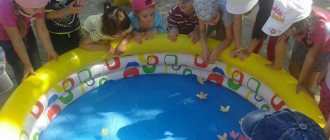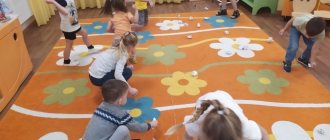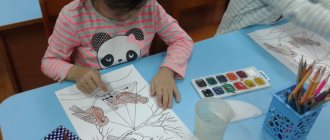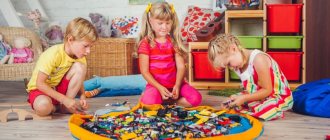Senior group. Senior preschool age. Children 5-6 years old
Play readings as a means of cultivating interest in literary creative activity in children of senior preschool age. In the Federal State Educational Standard, one of the main directions is the speech development of the child, mastering speech as a means of communication and culture; development of children's speech creativity. The highest form of speech development is literary creativity ,...
Abstract of the GCD on fiction in the senior correctional group “Reading the story by N. Kalinina “About Birds”
Goal: development of cognitive interest and expansion of knowledge about wintering birds. Objectives: • to form in children a holistic understanding of seasonal changes in nature; • teach children to listen carefully to the story and answer questions based on the content; • develop dialogical speech; •…
Summary of a lesson on familiarization with fiction in the senior group of kindergarten
Summary of educational activities for familiarization with fiction using the technology of productive reading in the senior group.
N. Nosov “Lollipop”. Author: Bykova Natalya Ivanovna, teacher of the Children's Educational Institution "Child Development Center - Kindergarten No. 110", Petrozavodsk Republic of Karelia Description of the material: The lesson notes were developed for children of the senior group, addressed to preschool teachers. The lesson uses productive reading and listening technology, which ensures children’s full perception and understanding of the text. Topic: Reading N. Nosov’s story “Lollipop”. Goal: To promote the assimilation of moral standards of behavior in children through familiarization with N. Nosov’s story “Lollipop”. Educational areas: social and communicative development, cognitive development, speech development, artistic and aesthetic development, physical development. Objectives: 1) Social and communicative development. Develop communication and interaction of the child with adults and peers. To cultivate moral ideas in children (truthfulness, honesty), to develop the ability to think and evaluate the actions of literary heroes. 2) Cognitive development. Continue to introduce children to the works of children's writer N. Nosov. Create a desire (motivation) to read a work of fiction. Develop curiosity, imagination and creativity. 3) Speech development. Develop coherent, grammatically correct dialogical and monologue speech. Enrich your active vocabulary. 4) Artistic and aesthetic development. Cultivate interest in works of fiction. 5) Physical development. Develop movement coordination. Material: portrait of N. Nosov, book by N. Nosov with the work “Lollipop”.
Move
1. Motivational stage. The teacher draws the children's attention to the new book. Educator: Guys, today I was given this wonderful book by Nikolai Nosov for our library. Are you familiar with this writer? What story have you already read? (“The Living Hat”) Who was this story about? (A story about two friends and a kitten on whom a hat fell from the chest of drawers. The boys at first thought that the hat had come to life and were very scared. But they soon found out why the hat was moving). Is the story “The Living Hat” funny or sad? (funny, cheerful) Educator: One of the stories in N. Nosov’s new book is called “Lollipop.” Do you know what a lollipop is? (A lollipop is a transparent candy made from a frozen mixture of sugar with water or fruit juice. Often attached to a stick). What is another name for candy? (candy, caramel) Guys, I just can’t tell what kind of story this is in terms of mood - funny or sad. Can you tell me? (children's answers) Probably, from the illustrations to this story, we will understand what kind of story it is.
Children look at the illustration and make their suggestions. 2. Indicative stage. Educator: Some of you think that this is a funny story, others think that it is sad. Guys, how do we know which assumption is correct? (you need to read the story). I’ll read this work now, and we’ll find out which of you was right. 3. Performing stage. 1) Reading-listening.
N. Nosov “Lollipop”
Mom was leaving home and said to Misha
(it is clear that this story is about a boy named Misha)
: “I’m leaving, Mishenka, and you behave well.”
Don't play around without me and don't touch anything. For this I will give you a big red lollipop (the lollipop was red, but it also comes in other colors)
.
Mom left. At first Misha behaved well: he didn’t play pranks and didn’t touch anything (what a fine fellow, he probably really wanted to get a lollipop from his mother)
.
Then he just placed a chair next to the buffet (a buffet is a cabinet with compartments for dishes)
, climbed onto it and opened the doors of the buffet.
He stands and looks at the buffet, and thinks: “I’m not touching anything, I’m just looking.” And in the buffet there was a sugar bowl (What is a sugar bowl? - Dishes for sugar)
He took it and put it on the table: “I’ll just look, but I won’t touch anything,” he thinks.
I opened the lid and saw something red on top (what could it be...)
.
“Eh,” says Misha, “but this is a lollipop.” Probably just the one my mother promised me. He reached into the sugar bowl and pulled out a lollipop. “Wow,” he says, “huge!” And, sweetie, it must be. (Do you think the sweet candy is delicious?)
Misha licked it and thought: “I’ll suck it a little and put it back.”
And he began to suck. He will suck and suck and see how much is left. And everything seems too much to him. Finally the lollipop became quite small, about the size of a matchstick. Then Mishenka put it back in the sugar bowl. He stands there, licks his fingers, looks at the candy, and thinks: “I’ll eat it completely.” Mom will give it to me anyway. After all, I behave well: I don’t play pranks or do anything like that.” Misha took out a lollipop, put it in his mouth, and wanted to put the sugar bowl back in its place. I took it, and it stuck to my hands (my hands were sticky from the candy)
- and thump to the floor!
It broke into two halves (of course, the sugar bowl broke, it’s made of porcelain or glass and is fragile
).
The sugar crumbled. Mishenka got scared: (the sugar bowl broke, the sugar scattered)
“What will mom say now!”
(What will Misha do next...)
He took the two halves and leaned them against each other.
They're okay, they're holding on. It’s not even noticeable that the sugar bowl is broken. He put the sugar back, covered it with a lid, and carefully placed it in the cupboard. Finally mom comes: - Well, how did you behave? - Good (Did Misha behave well?)
- What a clever girl!
Get a lollipop. Mom opened the cupboard, took the sugar bowl... Ah! The sugar bowl fell apart and sugar fell onto the floor. - What is it? Who broke the sugar bowl? - It's not me. It was she herself... - Oh, she crashed herself! Well it is clear. Where did the lollipop go? - Lollipop... lollipop... I ate it. I behaved well and ate it. Here... 2) General conversation. Educator: What kind of work is this: funny or sad? Why do you think so? Educator: What did the mother ask her son when leaving home? (behave well, don’t be naughty, don’t touch anything). Educator: How did Misha find the candy? (he placed a chair next to the buffet, climbed onto it and opened the doors of the buffet, took out a sugar bowl and opened the lid, there was a lollipop in the sugar bowl). Educator: What did Misha decide when he took the candy out of the sugar bowl? (“I’ll suck it a little and put it back”). Educator: Why did the sugar bowl break? (stuck to her hands) Educator: What did Misha do with the broken sugar bowl? (He took the two halves and leaned them against each other, folded the sugar back, covered it with a lid and carefully put it in the cupboard). Educator: How did the boy explain to his mother why he ate the candy? (He said: “I behaved well, and I ate a lollipop.”) Educator: What feelings did your mother experience at that moment, do you think? Educator: Did the mother scold her son? (did not scold) Educator: Do you think Misha deserves a lollipop? Educator: What advice would you give to the main character? 3).Reproduction of what has been read using tasks. Educator: I propose to play the game “Truth is not true.” If I tell you correctly, you clap your hands, if not, you stomp your feet. Game “True or false” - Is it true that mom promised Misha a car for obedience? “Is it true that mom promised Misha a lollipop for obedience?” - Is it true that Misha didn’t listen to his mother? - Is it true that Misha took out the lollipop and put it back? — Is it true that the boy ate the lollipop? — Is it true that the sugar bowl broke on its own? — Is it true that Misha was scared when the sugar bowl broke? “Is it true that when mom found the broken sugar bowl, she smiled?” “Is it true that when mom discovered the broken sugar bowl, she was upset?” — Is it true that Misha admitted that he ate the candy? 4. Reflective stage. Educator: Guys, what does N. Nosov’s story “Lollipop” teach? (Nosov’s story “Lollipop” teaches us to always honestly admit our guilt, not to be cunning and not to dodge. Misha did the wrong thing when he hid the broken sugar bowl in the cupboard. He should have immediately told his mother that he behaved badly and accidentally broke the sugar bowl). Educator: Guys, what did you understand when you listened to this story? (If you did something wrong, took something without asking, be prepared to have to answer). What lesson should we learn from this story? (Always tell the truth). Who would you tell this story to? The teacher invites the children to retell the text of the story in a chain and helps if necessary. 5. Promising stage. Educator: The author of this work is Nikolai Nosov. Imagine the author. How do you see it? (children's answers). The teacher shows a portrait of the writer.
Educator: Is this how you imagined the author? (children's answers) The teacher tells the children about the biography of the writer. Educator: Nikolai Nosov’s father was an artist. As a child, Nikolai Nosov loved to go to his father’s concerts and performances. And the parents thought that perhaps their boy would become an artist. When he was at school, he dreamed of becoming a great musician, he played the violin well, then he became interested in drawing, and dreamed of becoming an artist. He worked in cinema and made films. Nikolai Nosov became a children's writer completely by accident. It all started when he began to invent and tell funny stories to his son, and then he realized that this was the best activity for him that he could do. He made up stories about funny situations that he himself observed in life. Many cartoons were based on the works of N. Nosov. His books have been published in many countries around the world. Educator: Would you like to get acquainted with more stories by Nikolai Nosov? We will definitely read his other works. After class, the teacher suggests looking at the illustrations in the new book and determining which fragment of the story they relate to.
We recommend watching:
Summary of educational activities for speech development in the senior group. Retelling of Charushin's story “Hedgehog” Summary of a lesson on cognitive development in the senior group. Our assistants Notes of OOD on constructive model activities for children of the senior group Notes of a lesson in the senior group on the topic “Street of the native city”
Similar articles:
Lesson notes for the senior group of kindergarten. Kingdom of Three Minerals
Card index of fiction in the senior group under the program “From birth to school”
Lyubov Leonidovna Morozova
Card index of fiction in the senior group under the program “From birth to school”
O.O. Contents Author, title Purpose
Moral education
RNS "The Fox and the Jug"
arr. O. Kapitsa Cultivating good feelings; formation of ideas about greed and stupidity
rns “Winged, hairy and oily”
arr. I. Karnaukhova Teach children to understand the character and actions of heroes
X. Mäkelä. "Mr. Au"
(chapters, translated from Finnish by E. Uspensky
RNS "Khavroshechka"
arr. A. N. Tolstoy Cultivate manifestations of good feelings towards each other;
RNS "Bragging Hare"
arr. O. Kapitsa Develop standards of moral behavior
RNS "The Frog Princess"
arr. M. Bulatov Cultivate kindness and a sense of mutual assistance.
B. Shergin “Rhymes”
Cultivate a respectful attitude towards others
RNS "Sivka-Burka"
arr. M. Bulatov To develop in children the ability to evaluate the actions of heroes, to express their attitude towards them
RNS "Finist-Yasny Sokol"
arr. A. Platonov Cultivate a sense of compassion for others
V. Dragunsky “Childhood Friend”
,
“Top down, diagonally”
Cultivate attentiveness, love, compassion for your close comrade
S. Mikhalkov “What do you have?”
Nenets fairy tale "Cuckoo"
arr. K. Sharov Contribute to the cultivation of kindness, attentiveness and responsiveness to relatives
"Goldilocks"
, trans. from Czech K. Paustovsky;
cultivate the ability to empathize, be generous, and not envy others; develop self-respect and mutual assistance in work.
"Three golden hairs of Grandfather the Omniscient"
, trans.
from Czech N. Arosieva (from the collection of fairy tales by K. Ya. Erben)
.
V. Dmitrieva. “Baby and the Bug”
(chapters)
Feel and understand the character of the images
of a literary
work
L. Tolstoy “Bone”
To cultivate the moral qualities of the individual: honesty, truthfulness, love for family.
L. Tolstoy “Jump”
Arouse in children empathy for the hero of the story
N. Nosov. "Living Hat"
;
To form children's ideas about moral standards with the help of children's literature .
S. Georgiev. "I saved Santa Claus"
Develop the ability to evaluate one’s own actions and the actions of heroes, cultivate friendliness, and the ability to interact with peers
A. Lindgren. “Carlson, who lives on the roof, has arrived again”
(chapters, abbreviated, translated from Swede L. Lungina
K. Paustovsky. "Cat Thief"
Cultivate moral qualities: a sense of compassion, empathy
Mickiewicz Adam “To Friends”
To generalize and expand children’s knowledge about such concepts as “friend”
,
“friendship”
,
“honesty”
,
“justice”
P. Bazhov “Silver Hoof”
Foster a sense of kindness and caring for the weak
R. Kipling. "Baby elephant"
, trans. from English K. Chukovsky, poems in translation. S. Marshak Foster a culture of behavior, friendship, mutual assistance, care for loved ones
V. Kataev. "Seven-flowered flower"
To develop the ability to present the characteristics of one’s personality among peers, reflecting achievements and the reasons for possible difficulties.
Child in the family and in society RNS "Khavroshechka"
arr. A. N. Tolstoy Introduce different family relationships
Y. Koval “Grandfather, Grandmother and Alyosha”
To form in children an idea of a family as people who live together, love each other, and care for each other.
V. Dragunsky “Deniska’s stories”
Formation of ideas about the characteristic qualities of boys and girls.
A. Gaidar. “Chuk and Gek”
(chapters)
Learn to evaluate the relationships between close people in the family, compile characteristics of the heroes
E. Grigorieva “Quarrel”
Develop the basics of social interaction between boys and girls; friendly attitude towards the opposite sex
A. Barto “Vovka is a kind soul”
E. Blaginina “Let’s sit in silence”
Continue to form children’s idea of a kind attitude towards their mother
A. Usachev “What is etiquette”
Continue teaching the culture of speech communication in kindergarten and at home
"Krupenichka"
N. Teleshov Cultivate interest in fairy tales and Russian traditions
Self-service, labor RNS "Khavroshechka"
arr. A. N. Tolstoy Form children’s ideas about a hardworking person
K. Chukovsky “Moidodyr”
Education of cultural and hygienic skills
K. Chukovsky “Fedorino’s grief”
RNS "At the command of the pike"
To reinforce in children the concept of the importance of human labor
A. Barto “The Dirty Girl”
Cultivate neatness, careful attitude towards personal belongings, belongings of a friend
Y. Tuvim. “A letter to all children on one very important matter”
, trans. from Polish S. Mikhalkova
Formation of the foundations of security S. Mikhalkov “Uncle Styopa the policeman”
Reinforcement of rules of conduct on city streets
E. Segal “Cars on our street”
Cognitive development FEMP Reading books
Fairy tale heroes
S. Marshak “Numbers”
Getting to know the numbers
Introduction to the social world H. H. Andersen
"Snowman"
Getting to know New Year's traditions from different countries
S. Mikhalkov “What do you have?”
Introduction to the importance of any profession
“Wonderful stories about a hare named Lek”
, tales of the peoples of West Africa, trans. O. Kustova and V. Andreeva; Getting to know the characteristics of the peoples of West Africa
A. Gaidar “A Tale about a Military Secret, Malchisha-Kibalchisha and His Firm Word”
Continue to expand children's understanding of the Russian army.
Nenets fairy tale "Cuckoo"
arr. K. Sharov Acquaintance with the life of the peoples of the Far North
M. Boroditskaya “Waiting for Brother”
To form a desire to take care of children, to develop a sense of responsibility and respect for younger comrades
A. Tvardovsky “The Tankman’s Tale”
To form in children an idea of the feat of the people who stood up to defend their Motherland.
A. Barto “The Herd Game”
Expand children’s knowledge about their kindergarten, draw attention to its history, clarify ideas about the work of kindergarten employees
S. Makhotin “ Senior group ”
O. Vysotskaya
"Kindergarten"
T. Aleksandrova “Kuzka the Brownie”
(chapters)
Cultivate interest in the life of Russians in ancient times, love for the history of their people
M. Isakovsky “Go beyond the seas and oceans”
Clarify knowledge about your native country.
B. Almazov. "Gorbushka"
Introduction to Russian values;
Introduction to the natural world RNS "Bragging Hare"
arr. O. Kapitsa To form children’s caring attitude towards nature, the desire to take part in its conservation and protection.
L. Tolstoy. "The Lion and the Dog"
,
“Bone”
,
“Jump”
Expand ideas about animal life
G. Snegirev “Penguin Beach”
K. Paustovsky. "Cat Thief"
Foster love and respect for nature, kindness;
V. Bianchi “Owl”
Continue to form an idea of the interconnection and interdependence of living beings, an idea of
the literary genre “educational fairy tale”
;
B. Zakhoder “Gray Star”
To cultivate a sense of empathy and love for nature and man, the ability to resist evil
S. Yesenin “Bird cherry”
Help you feel the beauty of nature in a poem
R. Kipling. "Baby elephant"
, trans. from English K. Chukovsky, poems in translation. S. Marshak Develop fine motor skills, attention and interest in the animal world and its diversity
P. Bazhov “Silver Hoof”
Cultivate a sensitive attitude towards animals and a love of nature
Speech development Development of all aspects of speech
Introduction to Genres
Explanation of unfamiliar, outdated words
Artistic and aesthetic development Introduction to art V. Konashevich Acquaintance with illustrators
I. Bilibin
E. Charushin
Fine art activity Drawing illustrations based on works
Musical activity P. I. Tchaikovsky “The Nutcracker”
(fragments)
Introduction to the musical depiction of the heroes and images of the works
P. I. Tchaikovsky “The Seasons”
(fragments)
N. A. Rimsky-Korsakov “The Tale of Tsar Saltan”
(fragments)
S. Prokofiev “Peter and the Wolf”
Physical development
GCD and leisure activities based on the plots of works
Heroes of works




